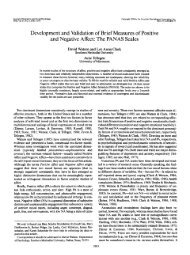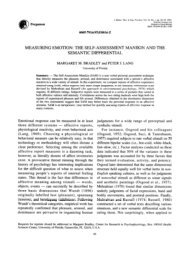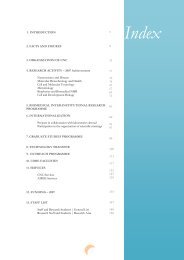Annual Report of Activities CNC 2008 - Center for Neuroscience and ...
Annual Report of Activities CNC 2008 - Center for Neuroscience and ...
Annual Report of Activities CNC 2008 - Center for Neuroscience and ...
You also want an ePaper? Increase the reach of your titles
YUMPU automatically turns print PDFs into web optimized ePapers that Google loves.
Membrane Toxicity | Head: Maria Amália JuradoObjectivesThe main purpose <strong>of</strong> our research has been to findout more about the particular role played by lipids<strong>and</strong> the lipid‐bilayer component <strong>of</strong> cell membranesin health <strong>and</strong> disease conditions. The emphasis ison biophysical properties <strong>of</strong> the lipid‐bilayer <strong>and</strong>on the way they affect membrane functions, that isa lipidomics approach. Advances in the elucidation<strong>of</strong> the aspects <strong>of</strong> lipid‐bilayer structure <strong>and</strong> dynamicspotentially involved in abnormal membranefunctioning <strong>and</strong> disease have been built uponexperimental approaches considering a serial stepwiseincrease in biological complexity, from modelmembranes prepared with synthetic <strong>and</strong> nativemembrane lipids, to subcellular fractions (biologicalmembranes, mitochondria, protoplasts) <strong>and</strong> prokaryotic<strong>and</strong> eukaryotic cell cultures. The area <strong>of</strong> researchhas included the study <strong>of</strong> a wide range <strong>of</strong>biological <strong>and</strong> chemical compounds, such as DNA,sterols, surfactants, drugs, environmental pollutants<strong>and</strong> nanomaterials.To investigate how membrane composition, structure<strong>and</strong> dynamics are involved in cell functioning ordysfunction, the group has been developing differentexperimental strategies, namely: a) To elucidate how cellfunctioning <strong>and</strong> pharmacological/toxicological effects <strong>of</strong>membrane‐active drugs are influenced by diet‐inducedmembrane lipid composition changes, in rats, <strong>and</strong> byalterations <strong>of</strong> membrane lipids as a response toenvironmental stress, in bacteria; b) To identifyalterations <strong>of</strong> the physical properties <strong>of</strong> the lipid bilayerrelated with cell malfunctioning <strong>and</strong> disease.Additionally, the group has been also interested on thecharacterization <strong>of</strong> DNA physical interactions with lipidmembranes, envisaging to contribute to the amelioration<strong>of</strong> liposomal gene delivery systems <strong>and</strong> to further clarifythe biophysical principles, which govern efficientliposome‐mediated transfection.Fig.1. Interaction <strong>of</strong> chemical agents with membranes. Smallmolecules interact with the membrane surface, in fluid (A) <strong>and</strong> lipidraft (B) domains, or penetrate in the membrane core (C).Nanostructures such as fullerenes (D) or lipid‐based DNA vectors(E) establish different interactions with the membrane, dependingon their size, surface chemistry <strong>and</strong> charge.Main AchievementsA large experience has been accumulated in our labconcerning pesticides effects on membrane physicalproperties using different model systems. Aparticularly important aspect <strong>of</strong> this work is theestimation <strong>of</strong> the partition coefficients <strong>of</strong> thecompounds in model <strong>and</strong> native membranes. Thesestudies are instrumental to evaluate their potential <strong>for</strong>uptake <strong>and</strong> accumulation in living cells. Thereafter,biophysical techniques, fluorescence spectroscopy,differential scanning calorimetry <strong>and</strong> magneticresonance spectroscopy ( 31 P‐NMR), have helped tocharacterise the perturbations promoted by thecompounds across the bilayer thickness <strong>and</strong> toidentify their potential accumulation in differentiatedregions <strong>of</strong> the heterogeneous membrane structure,allowing to predict a preferential interaction onspecific lipid‐protein environments.On the basis <strong>of</strong> collected data <strong>and</strong> knowledge, thesestudies have been extended to a variety <strong>of</strong>compounds whose physical‐chemical characteristicsmake them presumable disturbers <strong>of</strong> membraneproperties. Thus, the cellular effects <strong>of</strong> differentchemical compounds with pharmacological ortoxicological interest have been correlated to theirability to affect <strong>and</strong> modulate lipid‐membraneorganisation. Alterations induced in the structuralorder <strong>and</strong> organisation <strong>of</strong> lipid membranes haveshown to be strictly correlated with adverse effects onbioenergetics, cell growth <strong>and</strong> viability, suggesting tobe involved in xenobiotic mechanisms <strong>of</strong> actionfocused on the target cells <strong>and</strong>/or on xenobiotic nonselectiveside‐effects.We emphasise the following conclusive aspects:Bacterial models can be used as a suitable researchapproach to assess unspecific membrane cytotoxiceffects mediated by pesticides or drugs;Lipid composition changes induced by physical orchemical stress in bacteria have indicated thatrather than fluidity (the lipid membrane microstructure),other membrane properties, such asstructural heterogeneity <strong>and</strong> curvature stress,directly account <strong>for</strong> cell function impairment.Alterations <strong>of</strong> the structural order <strong>and</strong> organisation <strong>of</strong>membrane lipids, disturbance <strong>of</strong> the bilayer lateralpressure pr<strong>of</strong>ile <strong>and</strong> induction or remodelling <strong>of</strong> amembrane microphase pattern have beenidentified as common strategies <strong>for</strong> a variety <strong>of</strong>drugs <strong>and</strong> environmental pollutants to alter thehomeostatic equilibrium <strong>of</strong> biological systems.51






